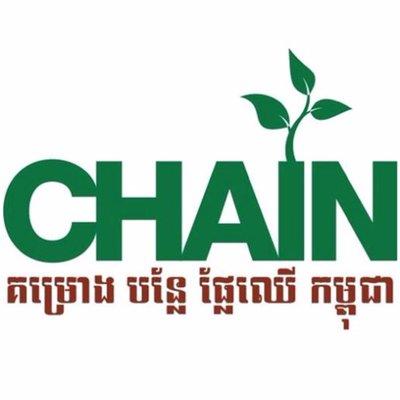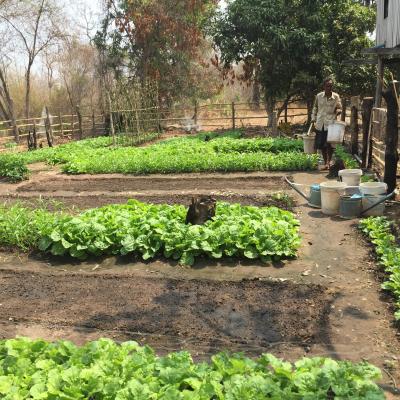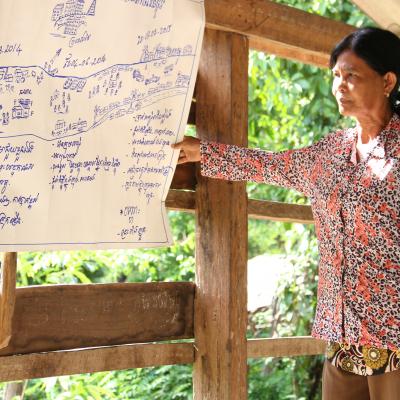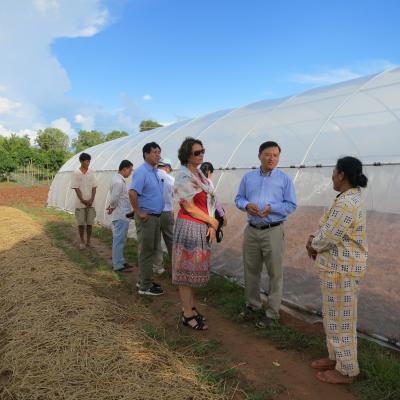CEDRIG Light
PDF ReportCambodian Horticulture Project Advancing Income and Nutrition (CHAIN) phase 3
Overview
General Information
Author
Moritz Krüger
Last updated
June 2021
Overall goal
Promotion of horticulture value chains in Preah Vihear, Stung Treng, Kratie and Oddar Meanchey provinces, with a strong focus on women and delivering sustainable income growth and improved household food security and resilience
Country
- Cambodia
Budget
CHF 1.900.000
Duration
01.01.2021 - 31.12.2022
Summary
Description
In Cambodia, more than 20 % of the rural poor suffer from food insecurity. The increasing market demand for safe vegetable and fruits provides a huge opportunity for small holder farmers and processors, in particular women to increase income and food security. The Cambodia Horticulture Advancing Income and Nutrition (CHAIN) project supports farmers in increasing sustainable production, income and resilience in four of the poorest provinces of Cambodia - Kratie, Stung Treng, Preah Vihear and Oddar Manchey. With the particular focus on the fruits and vegetables sector, CHAIN tackles market system constraints to improve the service delivery to poor farmers households, women headed households and ethnic minorities. CHAIN will support smallholder farmers to diversify into growing fruit and vegetables through the introduction of smart horticultural techniques ,water saving , and market linkages required to generate much-needed additional income, and it will also address poor household nutrition by introducing diversification of diets.
Keywords
- agriculture and food security
Sectors of Intervention
- Agriculture
- Food security
- Rural development
- Water management
- Vegetables Production
- Marketing
Documents
Images
Logos

Risk perspective
Hazards arising from environmental degradation
Hazard name
Deforestation
Exposure
Yes
Consequence
Alteration of hydrological cycle and micro-climate, reduced water availability
Consequence description
The changed hydrological cycle has increased the frequency of both floods and droughts.
Likelihood
Very likely
Extent
Extremely harmful
Risk Level
High risk
Hazard name
Pests and epidemics
Exposure
Yes
Comments
locust, rats, flea beetle larvae
Consequence
loss of income and crop production
Consequence description
Invasion of flea beetle larvae (Chrysomelidae: Alticini), which leads to a severe destruction of vegetables, especially root and leaf vegetables. Occurrence increased in the past 3-4 years.
Likelihood
Likely
Extent
Harmful
Risk Level
Medium risk
Hazard name
Water pollution (surface and subterranean)
Exposure
Yes
Comments
In 2018, warm army destroyed over than 10,000 ha of corn plantation. Water pollution is concern recently in Cambodia
Consequence
loss of fishery resources and income
Consequence description
Seasonal, severe invasion of Mekong river by a fist-thick layer of algae/aquatic plants which completely disrupt the normal fishing activities. This phenomenon started recently (around 2010-2012) and is observed in its maximum extension since a couple of years only.
Likelihood
Likely
Extent
Harmful
Risk Level
Medium risk
Natural hazards (hydro-meteorological and geological)
Hazard name
Heat waves
Exposure
Yes
Comments
Heat wave in 2016 destroyed many plots of vegetables farms . In 2016, People have to buy drinking water, the prices of water has almost three times increased
Consequence
higher freshwater demand for people and livestock. The level of water in many rivers are very low
Consequence description
People and animal get sick . Farmers earned less income
Likelihood
Likely
Extent
Slightly harmful
Risk Level
Low risk
Consequence
slower and reduced labour work
Likelihood
Likely
Extent
Slightly harmful
Risk Level
Low risk
Consequence
Heatstroke in particular for elderly and children
Likelihood
Likely
Extent
Harmful
Risk Level
Medium risk
Hazard name
Droughts
Exposure
Yes
Comments
In 2019 and 2020, most of water ponds were dried up, water level in many river are very low in historical and ground water level are dept. Deforestation reduce groundwater recharge, and increase evaporation and water demand during dry/hot season.
Consequence
reduced water availability
Consequence description
Reduced water availability for household consumption and agriculture, particularly of paddy rice, cassava, rubber, and maize.
Likelihood
Very likely
Extent
Harmful
Risk Level
High risk
Consequence
loss of crop production & income
Consequence description
Partially severe economic losses (also due to the lack of business continuity planning) for rice and vegetable farmers. Households with limited to no savings are left to buy seeds for next season or drinking water. Impacts from strong droughts may be felt for up to 2 years. As a result of low coping mechanisms, some communities may not recover from such loss.
Likelihood
Very likely
Extent
Harmful
Risk Level
High risk
Consequence
long-term immigration
Consequence description
migration occurs in various forms, both part-time and permanently, to urban areas, neighbouring countries or provinces
Likelihood
Likely
Extent
Extremely harmful
Risk Level
High risk
Hazard name
Flash floods, floods
Exposure
Yes
Comments
Flash flood in 2019, have destroyed some houses and many vegetables farms were washed away. Dam broken in Laos in 2018 destoyed hundreds of houses in two provinces. Many people were evacuated.
Consequence
loss of crop production & income
Consequence description
Long-lasting episodes with too much rain cause rotting of rice plants & vegetables during rainy season. The existing drainage and irrigation practices used by communities are largely insufficient to ensure the survival of crops and seeds during and after intense rain episodes followed by severe droughts.
Likelihood
Very likely
Extent
Harmful
Risk Level
High risk
Consequence
destruction of houses & infrastructure, disruption of market access
Likelihood
Very likely
Extent
Harmful
Risk Level
High risk
Hazard name
Storms, tornadoes, hurricanes, strong winds, sandstorms
Exposure
Yes
Comments
Seasonal storms and strong winds destroyed over than 1000 houses and thousands of trees. Lightening killed animals and people
Consequence
Damage to houses and buildings.
Consequence description
Destruction of light agricultural infrastructure (bamboo scaffolding, nets etc.), damage to houses and critical roads/bridges. Storms and strong winds are observed more frequently in past years. Impacts are rather local.
Likelihood
Likely
Extent
Slightly harmful
Risk Level
Low risk
Hazards arising from climate change (and climate variability)
Hazard name
General trends towards higher or lower mean annual temperatures
Exposure
Not sure
Comments
higher mean annual temperature +5-10% (rel. term)
Consequence
higher water demand for people, livestock and agriculture
Likelihood
Likely
Extent
Harmful
Risk Level
Medium risk
Consequence
decrease of crop productivity
Consequence description
Decrease in suitability in the production of paddy rice, (++) cassava (++), soya (+), maize (+), rubber (+), and in livestock rearing (+).
Likelihood
Likely
Extent
Harmful
Risk Level
Medium risk
Consequence
diminishing of groundwater resources
Likelihood
Very likely
Extent
Harmful
Risk Level
High risk
Hazard name
Changes in frequency and intensity of climatic extreme events and associated disasters (e.g. cold and heat waves, flood, drought, storms, hurricanes, cyclones)
Exposure
Yes
Comments
higher frequency and unpredictability of high rainfall events
Consequence
loss of crop production due to non-timely sowing and planting (traditional knowledge is no longer applicable)
Likelihood
Likely
Extent
Extremely harmful
Risk Level
High risk
Consequence
Higher irregularity of the rainy season
Consequence description
Earlier onset of the hot season and prolonged duration. Shortened rainy season. A new sequence of flood-drought-flood episodes is observed during the rainy season: flood episode in June-July (too much rain) followed by drought in August (no rain at all), immediately followed by flood situation Aug-Sept (too much rain). This lead to higher demand for adequate early warning systems. Rain was delayed in 2019 and 2020, started only in mid of June.
Likelihood
Likely
Extent
Extremely harmful
Risk Level
High risk
Detailed risk assessment needed?
Impact perspective
Estimate impact on the environment
Environmental Area
Water
Component of the activity
Capacity building of farmers and processors for increased sustainable production, including year-round production and performance
Impact on environment
Higher agricultural performance and year-round production will increase the demand for water resources.
Estimate impact on disaster risks
Component of the activity
Improved income and productivity of smallholder horticulture
Exacerbated or newly created risk
More cycles of horticulture production may put pressure on the already stressed water resources in some places even more in some places. An integrated water resources management, based on surface & groundwater is needed, not to exacerbate the risk of future droughts.
Estimate impact on climate change
Component of the activity
None




Comments
Massive deforestation in Cambodia is highly likely to be the root cause of the devastating change in the observed rainfall pattern. It is caused by legal (attribution of land concession to foreign companies, building of roads in forested area, etc…) and illegal logging.